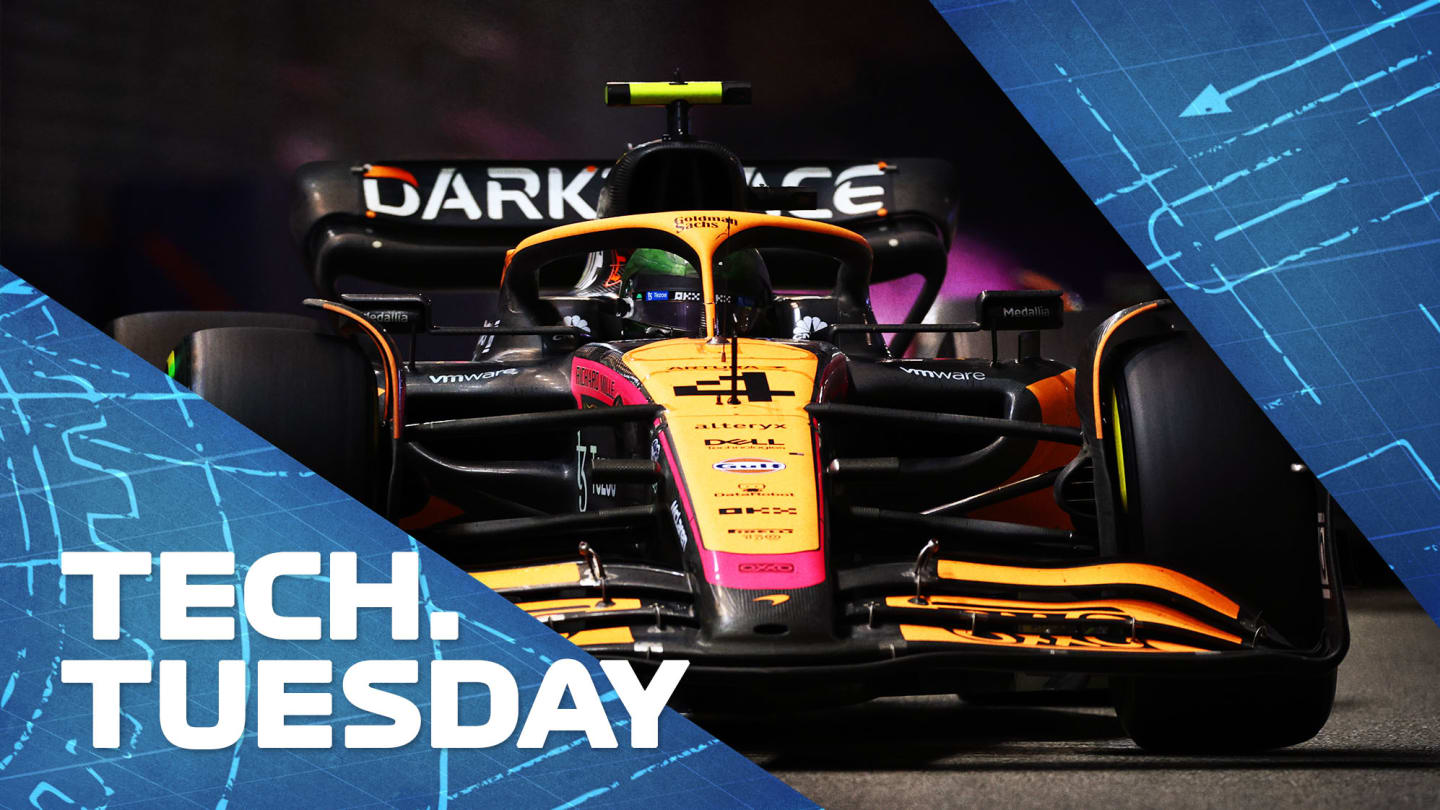
Technical
TECH TUESDAY: Have McLaren signalled a new design direction for F1 cars with their Singapore GP update?

Share

Despite the fact that it was the new radiator inlets which caught the attention of McLaren’s Singapore upgrade, that was probably not the most significant aerodynamic change to the MCL36. F1 technical expert Mark Hughes takes a closer look at McLaren’s Singaporean changes, with illustrations from Giorgio Piola.
McLaren are seeking to endow the car with a more consistent aerodynamic performance at all the different rear ride heights the car will see, so as to give a more consistent balance throughout the corner speed range.
The rear ride height of any car lowers the faster the corner, as the aerodynamic forces push down on the car’s suspension. In slower speed corners, as the rear ride height increases, it can lead to a detachment of the airflow as that air is no longer moving so quickly and is therefore less robust in its flow patterns.
Teams seek to maintain as much consistency as possible in the car’s balance between high speed and low to create the biggest possible operating window. The wider that window of balance between the front and rear of the car throughout the speed range, the more total downforce can usually be generated. Maintaining good airflow through the rear underbody at lower speeds is crucial in this.

McLaren have sought to widen the operating window of balance between the front and the rear of the car through the corners
In designing the various surfaces of the car which define that airflow, it may even be advantageous to lose some of the high-speed downforce if that allows a more consistent, less stall-prone flow pattern through the underbody at low speeds.
This is something that McLaren technical chief James Key alluded to in Singapore. “You can’t see it, but there’s a lot of detail beginning to develop in the underfloor now. Lots of surfaces and things that don’t look logical when you just think about the real basics of ground effect, but actually make the differences. The bits you can’t actually see are some of the most effective parts.”
WATCH: Andreas Seidl on McLaren's 'concept change'
In terms of the basics of ground effect which Key references, the greater the air pressure difference between the underfloor (low pressure) and the car’s upper surface (high pressure) created by the venturi tunnels in the floor, the more downforce is created. But the bigger and more aggressively-shaped those tunnels are in creating low pressure, the more stall-prone they can become at lower speeds.
This is where the underfloor needs the most help from the upper body surfaces in keeping that pressure difference strong at the bigger ride heights encountered at lower speeds. So it could well be that what Key describes as changes ‘which don’t look logical’ have actually increased performance.

The slight increase in radiator inclination angle in the new sidepod concept, shown on the right versus the old concept on the left, has facilitated the paring away of upper bodywork over the inlet
The eye-catching changes to the radiator inlets – together with changes to the leading edge of the floor, the tunnel inlet vanes and the floor edges – are just part of feeding a stronger upper body help to the underfloor at the rear corners of the car.
“This package has got quite a lot of mechanical changes under the skin to allow some of the shapes to develop,” says Key. This may well be a reference to the angle of the radiators behind their new inlets. The bodywork forming the top of the inlet has been pared back (forming the ‘shelf’ at the lower part of the inlet, which remains where it was).
This paring back allows a deeper angle of downward ramp of the whole sidepod and it is this ramp which is such a powerful part of accelerating the airflow which feeds the rear corners of the car to form the pressure difference between the underfloor and upper surfaces there. Inclining the radiators more steeply will have allowed that upper inlet to be pared back.

Key called the upgrades “a logical step” with “some conceptual changes”
The changes to the leading edge of the floor, the tunnel vanes and floor edges are all consistent with boosting the power of that airflow to the rear corners of the car, even possibly at the expense of how much volume of air is used to feed the underbody. There is only so much volume of air available and aerodynamicists are constantly looking for the most effective split between feeding the underfloor and upper body surfaces.
The pressure difference created by those two flows is what creates the downforce, but that difference changes with the speed of the car and the rear ride height.
READ MORE: 5 Winners and 5 Losers from the Singapore GP – Who shone under the lights at Marina Bay?
Lap time trumps all in deciding where this compromise lies and McLaren are refining this compromise. It offers clues as to the future design direction of F1 as other teams begin to realise the reasons for the effectiveness of the Red Bull and Ferrari.
“This upgrade is a logical step,” continues Key. “It does follow on from what we did in the France update but there’s some conceptual changes on it as well, which are quite different. That’s the first step towards a new concept.”
YOU MIGHT ALSO LIKE
Feature POWER RANKINGS: Who impressed our judges across a dramatic Spanish Grand Prix weekend?
News Aston Martin's Krack provides more background on Stroll’s injury with ‘Plan A’ for Canadian to race on home soil
News Downbeat Hamilton says he learned ‘absolutely nothing’ from triple header after tough run to P6 in Barcelona
Feature What the teams said – Race day in Spain




